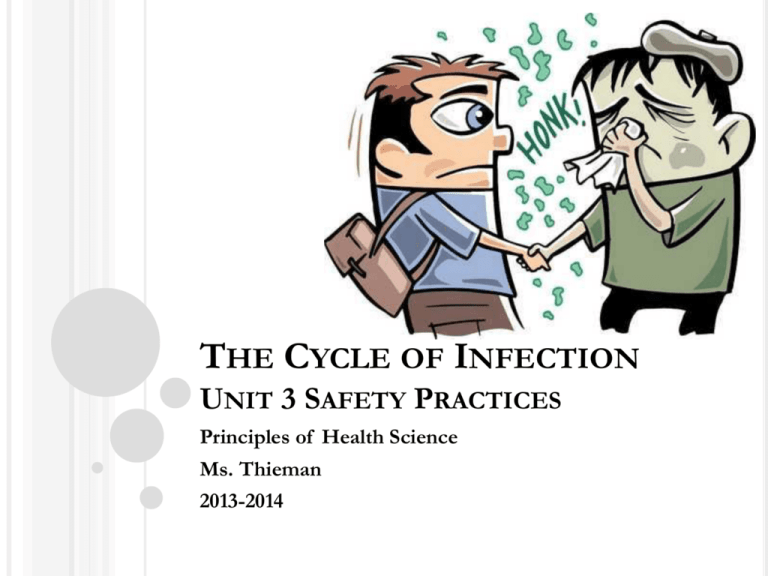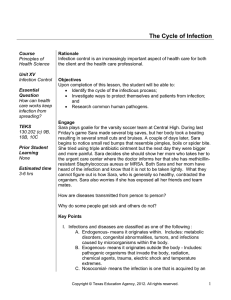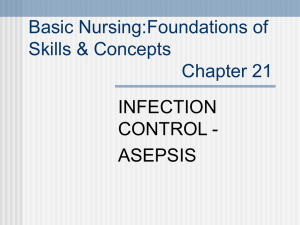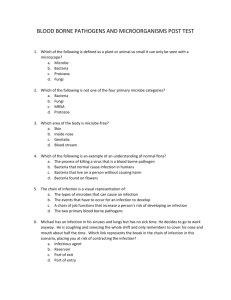File
advertisement

THE CYCLE OF INFECTION UNIT 3 SAFETY PRACTICES Principles of Health Science Ms. Thieman 2013-2014 RATIONALE & OBJECTIVES Infection control is an increasingly important aspect of health care for both the client and the health care professional. Upon completion of this lesson, the student will be able to: Identify the cycle of the infectious process Investigate ways to protect themselves and patients from infection Research common human pathogens ENGAGE Sara plays goalie for the varsity soccer team at Central High. During last Friday’s game Sara made several big saves, but her body took a beating resulting in several small cuts and bruises. A couple of days later Sara begins to notice small red bumps that resemble pimples, boils or spider bite. She tried using triple antibiotic ointment but the next day they were bigger and more painful. Sara decides she should show her mom who takes her to the urgent care center, where the doctor informs her that she has methicillin resistant Staphylococcus aureus or MRSA. Both Sara and her mom have heard of the infection and know that it is not to be taken lightly, what they cannot figure out is how Sara who is generally so healthy contracted the organism. Sara also worries if she has exposed all her friends and teammates. Essential questions: How are diseases transmitted from person to person? Why do some people get sick and others do not? INFECTION AND DISEASE CLASSIFICATIONS Endogenous- “originates within” (metabolic disorders, congenital abnormalities, tumors, and infections caused by microorganisms within the body) Exogenous- “originates outside the body” (pathogenic organisms that invade the body, radiation, chemical agents, trauma, electric shock and temperature extremes) Nosocomial- infection is acquired by an individual in a health care facility that’s transmitted by health care worker to the patient Opportunistic- infections that occur when the body’s defenses are weak (*they look for an “opportunity” :) Aerobic- the organism requires oxygen to live. Anaerobic- lives and reproduces in the absence of oxygen. THE CHAIN OF INFECTION *VIDEO HTTP://WWW.YOUTUBE.COM/WATCH?V=2RGAXDDEK6K Infectious Agent The Chain of Infection Infectious Agent Reservoir Host The Chain of Infection Infectious Agent Reservoir Host Portal of Exit The Chain of Infection Infectious Agent Reservoir Host Portal of Exit Mode of Transmission The Chain of Infection Infectious Agent Reservoir Host Portal of Exit Portal of Entry Mode of Transmission The Chain of Infection Infectious Agent Reservoir Host Susceptible Host Portal of Exit Portal of Entry Mode of Transmission THE INFECTION CYCLE IS WELL DEFINED: Infective agent: Common pathogens include bacteria, viruses, funguses, rickettsiae, protozoa Reservoir Place where causative agent can live Common reservoirs include human body, animals, environment, and fomites or objects contaminated with infectious material that contains the pathogens Portal of exit Way for causative agent to escape from the reservoir Pathogens can leave the body through urine, feces, saliva, blood, tears, mucous discharge, sexual secretions, and draining wounds THE CYCLE OF INFECTION CONTINUED… Means of transmission Pathogen must be transmitted to another reservoir (or host) where it can live Pathogen can be transmitted in different ways Direct Contact Person-to-person spread by physical contact Contact with the body secretions containing pathogen Indirect contact Pathogen is transmitted from contaminated substances (i.e. food, air, soil, insects, feces, clothing, instruments, and equipment) Touching contaminated equipment Breathing in droplets carrying airborne pathogens Receiving the bite of an insect carrying pathogen THE CYCLE OF INFECTION CONTINUED… Portal of entry Way to enter a new reservoir or host Means of entry Breaks in the skin or mucous membrane Respiratory tract Digestive tract Genitourinary tract Circulatory system Susceptible host Individual who can contract the disease Humans may fight off causative agents and do not contract disease if Defense mechanisms of body are intact Immune system functioning Human becomes susceptible host in some instances Large numbers of the pathogen invade the body Body defenses are weak THE CYCLE OF INFECTION CAN BE BROKEN AT ANY LINK OF THE CHAIN… The infectious agent can be neutralized or destroyed by treatment The reservoir host must maintain personal hygiene The portal of exit is closed by the use of proper attire (gowns, gloves, other clothing), control of body secretions, and proper handwashing The route of transmission is minimized through proper handwashing, disinfection and sterilization, and proper disposal of contaminated materials. The portal of entry is blocked by asepsis, disinfection, and sterilization procedures. Host susceptibility is broken when the health and wellness of an individual is maintained. MICROORGANISMS AND DISEASE Microorganism: organism that’s too small to be seen by the human eye. Fungi: simple plants like molds & yeasts, some which cause disease. Protozoa: the only group of microorganisms classified as an animal. Virus: microorganisms that are so small they cannot be seen with an ordinary light microscope. They are not destroyed by antibiotics. Bacteria: microorganisms first seen under the microscope by Antoni van Leeuwenhoek in 1693. The classification is determined by the shape of the bacteria and whether it grows with or without oxygen. Only a few bacteria, such as staphylococcus and streptococcus cause disease. Aerobic bacteria: live and multiply in the presence of oxygen. Anaerobic bacteria: live and multiply without oxygen Rickettsiae: smaller than bacteria, barely visible under light microscope; cause typhus, Rocky Mountain spotted fever. Pathogen: a disease causing microorganism. ASEPSIS: THE ABSENCE OF INFECTION Medical asepsis: practices and techniques that are designed to protect individuals from the spread of disease. Antiseptic: substances that inhibit the growth of bacteria. Some of these substances can be used on the skin. Disinfectant: substances or practices that cannot be used on the skin. This includes chemicals and boiling. Sterile: absence of all microorganisms. Surgical asepsis: the use of sterile technique to handle equipment, maintain sterile fields, change dressings and dispose of contaminated materials without introducing harmful microorganisms. EPIDEMIOLOGY: TRACING THE OCCURRENCE OF HEALTH RELATED EVENTS IN SOCIETY. Epidemiologist: a person who specializes in the study of outbreaks of diseases within a population group. Endemic: refers to the ongoing presence of a disease within a population, group, or area. For example, the common cold is always present within a population. Epidemic: is a sudden and widespread outbreak of a disease within a population, group or area. For example a sudden wide spread outbreak of measles is an epidemic. Pandemic: refers to an outbreak of a disease occurring over a large geographic area, possibly worldwide. For example, AIDS is pandemic. ACTIVITY CREATE MOBILES OF VARIOUS MICROORGANISMS. (EACH SHOULD HAVE IDENTIFYING INFORMATION TELLING ABOUT THE MICROBE, WHAT DISEASE(S) IT CAUSES, EPIDEMIOLOGY, TREATMENT, AND TREATMENT SUCCESS RATE). RESEARCH AND INVESTIGATE COMMON HUMAN PATHOGENS IN SMALL GROUPS. PROJECT GUIDELINES. ANY QUESTIONS?








